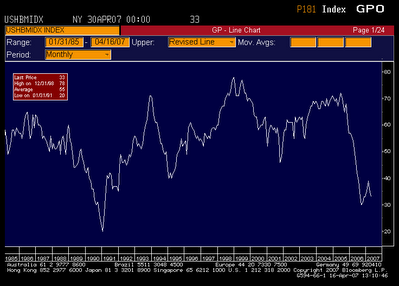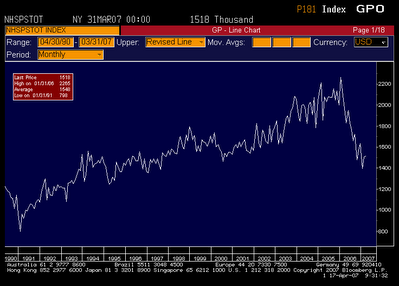By Bonddad
Bonddad@prodigy.net
Don't blame me -- I didn't cause this. The news about the housing market is still coming in -- and it ain't good. Below are the big developments from the last week or so.
The National Association of Home Builders/Wells Fargo index of sentiment fell to 33 from 36 in March, the Washington-based association said today. A reading below 50 means most respondents view conditions as poor.
According to today's report, single-family home sales have fallen this month and builders' outlooks for the next six months are at the lowest level since October. That, along with rising defaults on subprime mortgages and excess inventory levels, suggests a greater drag on construction this year.
``The tightening of mortgage lending standards in connection with the subprime crisis has shaken the confidence of both consumers and builders,'' David Seiders, chief economist at the NAHB, said in a statement. ``While we still expect to see some improvements in housing market activity beginning later this year, the downside risks and uncertainties surrounding that forecast are considerable.''
Here's a chart of the index from the blog Interest Rate Roundup:
This is a really good statistical indicator because it asks people in the industry how they feel about the market. These are people who should know what is going on. And the answer is, they aren't that thrilled by what they see. In addition, when an economist says, "the downside risks and uncertainties surrounding that forecast are considerable." you know there's a high possibility of trouble down the road.
Foreclosures double from year-ago levels
Owners of 168,829 homes in the first three months of 2007 got notices that lenders had filed for foreclosure due to failure to pay loans or liens, Foreclosures.com said yesterday.
That compares with 83,154 homes in the same period of 2006, the Sacramento, Calif.-based research firm said.
A four-year high in mortgage payment delinquencies and the failure or sale of 50 subprime mortgage companies, which provide loans to people with poor or limited credit histories, have made credit less available.
The inability of homeowners to refinance their debt has added to the rise in foreclosures.
This number is bad for one very important reason: we're still in an economic expansion. Foreclosures should increase in a recession or just after a recession. If foreclosures start to double before a recession, then there will be real trouble if a recession hits.
And here's some data from California:
The number of default notices sent to California homeowners last quarter increased to its highest level in almost ten years, the result of flat appreciation, slow sales, and post teaser-rate mortgage resets, a real estate information service reported.
Lending institutions filed 46,760 Notices of Default (NoDs) during the January-to-March period. That was up by 23.1 percent from a revised 37,994 for the previous quarter, and up 148.0 percent from 18,856 for first-quarter 2006, according to DataQuick Information Systems.
Last quarter's default level was the highest since 47,912 NoDs were recorded statewide in second-quarter 1997. Defaults peaked in first quarter 1996 at 61,541. An average of 33,847 NoDs have been filed quarterly since 1992, when DataQuick's NOD statistics begin.
Housing Starts Increase .8%
Housing starts in the U.S. unexpectedly rose for a second month in March, bolstering expectations the worst housing slump in 15 years may be easing.
Builders broke ground on new homes at an annual rate of 1.518 million last month, an increase of 0.8 percent from February, the Commerce Department said today in Washington. Building permits, a sign of future construction, also rose 0.8 percent.
Unusually warm temperatures last month encouraged builders to start work on more homes, along with signs that demand is starting to firm as prices moderate. The Federal Reserve predicts the economy will pick up in the course of the year as the drag from housing diminishes, while warning that a wave of mortgage defaults poses a risk to their forecast.
Before we start jumping for joy, let's look at the long-term trend, again from Interest Rate Roundup.
We're still in a downtrend.
More importantly is the total number of homes on the market. According to the Census Bureau, there were 538,000 new homes in inventory in February 2006 and 546,000 in February 2007. That means we have an 8-month supply of new homes on the market at current sales rates. Also remember that credit standards are tightening, which means demand will probably shrink going forward. Short version -- there are still a ton of homes on the market.
The end result of all this information is clear: housing isn't near a bottom, and probably won't be for the foreseeable future.
A second end result. Barry Ritholtz over at the Big Picture blog is calling this a slow-motion slowdown. I think he's right. I thought housing problems were going to kill the economy by now. While all of these housing problems has hit GDP growth over the last three quarters we're still in positive GDP territory. With a ton of mortgage resets still coming, low capital investment and consumers in debt up to their eyeballs, we're probably going to have a continual drip-drip-drip of news like this for the foreseeable future. Eventually, these events stand about a 50% chance of sending the economy into a recession.
For economic commentary and analysis, go to the Bonddad Blog


No comments:
Post a Comment